Embarking on a culinary journey often involves navigating the delightful maze of diverse dishes, each offering a unique symphony of flavors. In the spotlight today are two vegetarian titans – Veg Biryani and Veg Fried Rice.
As we delve into the aromatic realms of these beloved dishes, we’ll unravel their origins, explore the burst of colors and flavors, and decipher the cooking techniques that set them apart.
Join us as we embark on a flavorful face-off between Veg Biryani and Veg Fried Rice, each vying for a spot on your plate and in your heart. Get ready to be tantalized by the culinary clash that promises a feast for your taste buds!
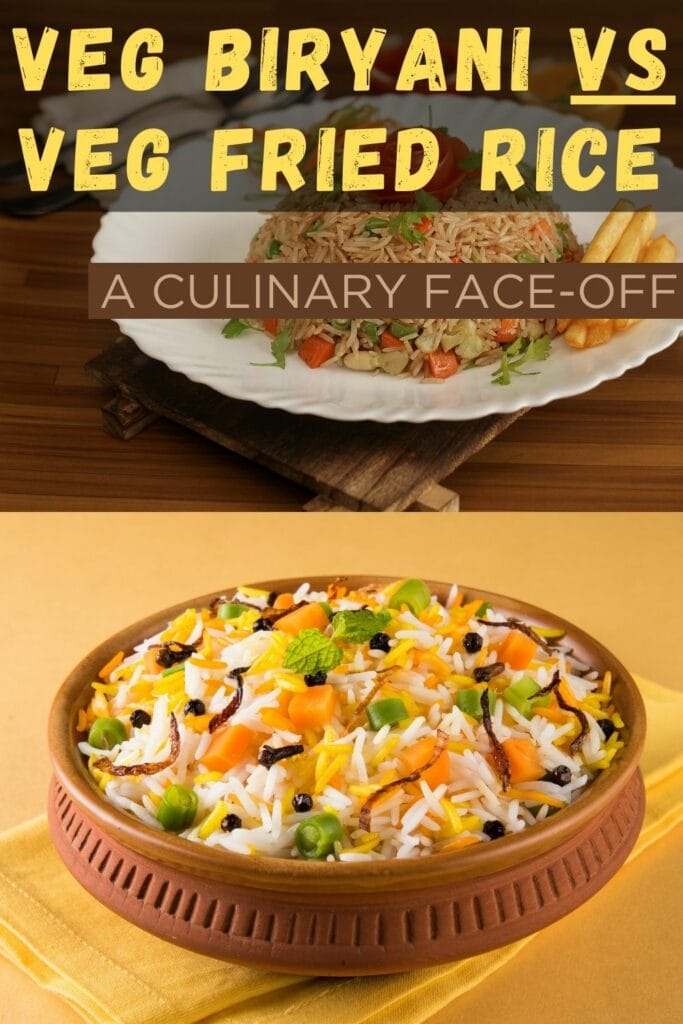
Table showing differences between Veg Biryani and Veg Fried Rice
| Factors | Veg Biryani | Veg Fried Rice |
|---|---|---|
| Differences in Origin | Mughlai cuisine, India | East Asian cuisine, China |
| Differences in Color | A riot of hues – golden, green, brown | Subtle elegance with muted tones |
| Differences in Flavor | Aromatic blend of spices, rich and robust taste | Savory simplicity, subtle flavors |
| Difference in Rice Used | Basmati rice with long grains | Jasmine rice with shorter grains |
| Difference in Texture | Layered elegance with varied textures | Wok-kissed simplicity, harmonious blend |
| Difference in Cooking Time | Time-consuming due to dum cooking | Quick stir-frying, ideal for quick meals |
| Difference in Method of Cooking | Dum cooking technique, slow-cooked | Stir-frying in a wok, quick and intense |
| Difference in Serving | Royal plating, fit for feasts | Casual and approachable, simple presentation |
| Difference in Ingredients | Aromatic extravaganza with diverse spices and herbs | Simple harmony with key ingredients, soy sauce, and sesame oil |
| Difference in Nutritional Value | Decadent indulgence, higher calories | Balanced simplicity, generally lower calories |
Veg Biryani: A Flavorful Delight
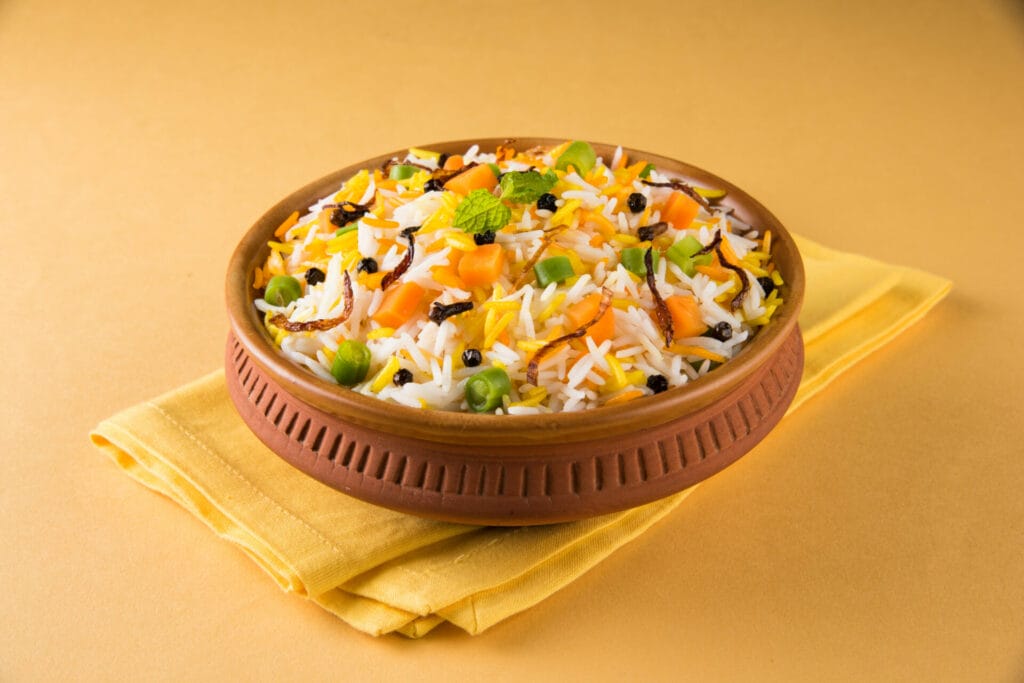
When it comes to indulging in the rich tapestry of Indian cuisine, one dish that stands out for its aromatic blend of spices and diverse flavors is none other than the beloved Veg Biryani. This rice-based dish is a celebration of textures, colors, and fragrances, making it a favorite among food enthusiasts and families alike.
The Essence of Veg Biryani
Veg Biryani is a traditional Indian dish that originated in the Mughlai cuisine, and over the years, it has evolved into a culinary masterpiece with regional variations. The heart of this dish lies in the fragrant basmati rice, cooked to perfection and layered with a medley of fresh vegetables and aromatic spices.
The Art of Preparation
Creating the perfect Veg Biryani is a culinary journey that involves several steps, each contributing to the dish’s unique taste. The rice is first parboiled, ensuring it retains its shape and does not become mushy. Meanwhile, an array of vegetables like carrots, peas, and potatoes are sautéed in a melange of spices, such as cumin, coriander, and garam masala.
Once the vegetables are imbued with the aromatic spices, they are carefully layered with the partially cooked rice in a deep-bottomed pot. To elevate the flavors, saffron-infused milk and fried onions are often added between the layers, creating a symphony of tastes that culminate in a mouthwatering dish.
The Dum Cooking Technique
One of the defining features of Veg Biryani is the dum cooking technique. The layered pot is sealed with a tight-fitting lid, and the dish is slow-cooked over low heat. This method allows the rice to absorb the flavors of the vegetables and spices, resulting in a biryani that is not only visually appealing but also bursting with taste.
Serving Suggestions
Veg Biryani is often served with a side of raita, a yogurt-based condiment that adds a cooling contrast to the robust flavors of the biryani. Some also enjoy it with a squeeze of lemon or accompanied by a spicy curry. The beauty of Veg Biryani lies in its versatility, making it suitable for a cozy family dinner or a festive feast.
In conclusion, Veg Biryani is more than just a dish; it’s a culinary experience that brings people together through the joy of savoring a harmonious blend of spices and textures. The next time you crave a taste of India on your plate, consider diving into the world of Veg Biryani for a delightful and aromatic adventure.
Veg Fried Rice: A Wok-Fired Delight
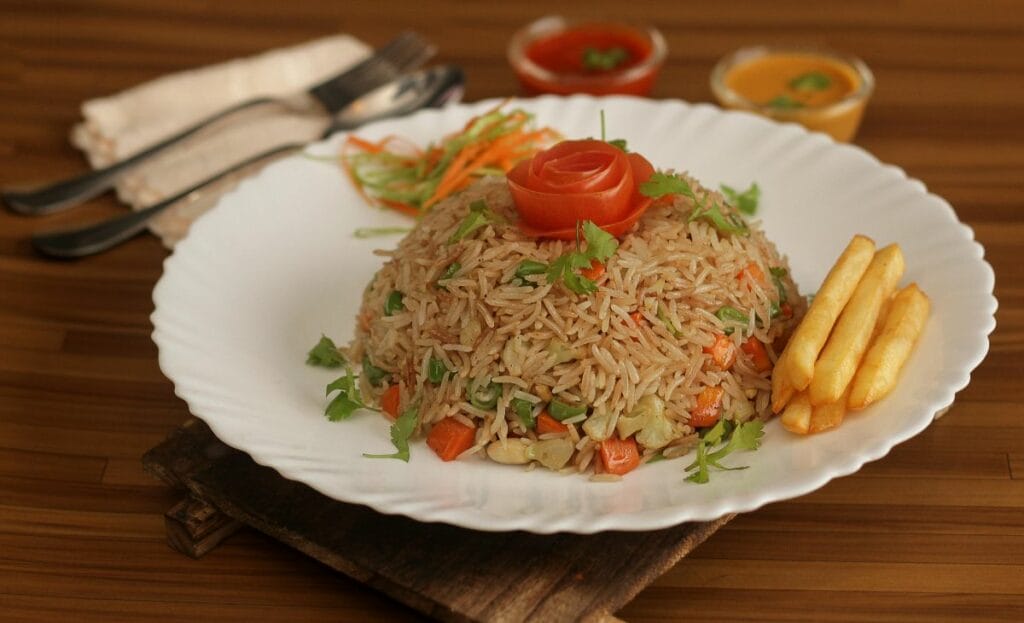
Let’s take a flavorful detour from the aromatic world of biryanis and dive into the enticing realm of Veg Fried Rice. This beloved Asian-inspired dish has a distinct charm of its own, offering a symphony of tastes and textures that make it a quick and satisfying option for those seeking a delicious meal on the go.
The Basics of Veg Fried Rice
Veg Fried Rice is a versatile dish that hails from East Asian cuisine, particularly China. It’s a delightful medley of cooked rice, vibrant vegetables, and a savory blend of sauces, all stir-fried to perfection in a hot wok. The beauty of this dish lies in its simplicity, allowing the individual flavors to shine through with each delectable bite.
Ingredient Harmony
The key to a great Veg Fried Rice lies in the harmonious combination of ingredients. Cooked jasmine or basmati rice serves as the foundation, providing a light and fluffy texture. Vegetables like carrots, peas, bell peppers, and spring onions add a burst of color and freshness. To enhance the flavor profile, soy sauce, sesame oil, and a pinch of salt and pepper are introduced, creating a savory dance on the taste buds.
The Wok Magic
The magic happens in the wok – a versatile cooking vessel that allows for quick and even cooking. The rice and vegetables are tossed together in the wok over high heat, ensuring a delightful smokiness and a perfect blend of flavors. The quick cooking process retains the crunchiness of the vegetables while imparting a tempting aroma to the dish.
Customization Galore
One of the delights of Veg Fried Rice is its adaptability. You can personalize it to suit your taste preferences by adding protein like tofu, paneer, or even leftover shredded chicken. The beauty of this dish is that it welcomes creativity, making it a go-to option for a quick and customizable meal.
Serving Suggestions
Veg Fried Rice can stand alone as a satisfying meal or be paired with a variety of sides. It complements well with classic accompaniments like vegetable Manchurian, chilli paneer, or a simple bowl of hot soup. Whether enjoyed as a quick lunch option or served as a side dish in a grand feast, Veg Fried Rice brings a delightful fusion of flavors to the table.
In conclusion, while Veg Biryani and Veg Fried Rice may belong to different culinary traditions, they both share the common goal of delighting our taste buds. The next time you’re torn between the aromatic spices of biryani and the sizzling stir-fry of fried rice, let your cravings guide you through this delightful culinary journey.
Difference between Veg Biryani and Veg Fried Rice (Detailed breakdown)
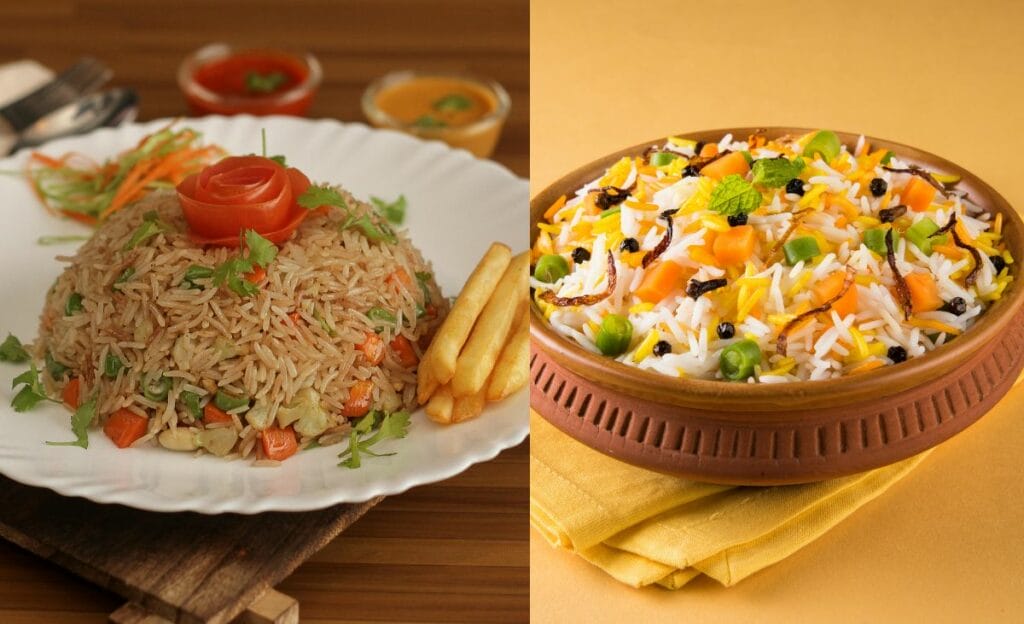
Difference in the Origin
Veg Biryani: A Mughlai Marvel
Veg Biryani, with its roots deeply embedded in Mughlai cuisine, showcases the opulent culinary heritage of India. Originating from the royal kitchens of the Mughal emperors, this aromatic dish is a celebration of flavors, with fragrant basmati rice, vibrant vegetables, and a symphony of spices.
Veg Fried Rice: An Asian Affair
On the flip side, Veg Fried Rice takes us on a journey to East Asia, particularly China. This stir-fried wonder emerged as a street food favorite before spreading its popularity globally. The simplicity of combining rice, vegetables, and savory sauces in a wok gives it an Asian flair that’s distinct from the royal decadence of Veg Biryani.
Differences in Color
Veg Biryani: A Riot of Hues
The color palette of Veg Biryani is a feast for the eyes. The golden tones of saffron-infused rice, the verdant greens of fresh cilantro and mint, and the earthy browns of perfectly caramelized onions create a visually stunning dish. The vibrant hues are not just a treat for the palate but also a feast for the senses.
Veg Fried Rice: Subtle Elegance
In contrast, Veg Fried Rice exudes a more subtle elegance. The dish showcases a beautiful balance of muted tones from the lightly colored rice and a diverse mix of vegetables. The focus here is on the harmony of ingredients, creating a visually appealing yet understated presentation.
Differences in Flavor
Veg Biryani: A Melange of Spices
The flavor profile of Veg Biryani is a sensory adventure. The aromatic blend of spices like cumin, coriander, and garam masala creates a rich and robust taste. The slow-cooking technique of dum further intensifies the infusion of flavors, offering a biryani that’s not just a meal but a culinary experience.
Veg Fried Rice: Savory Simplicity
Veg Fried Rice, in contrast, embraces the beauty of simplicity. The flavors are more subtle, with the nuttiness of sesame oil, the umami from soy sauce, and the freshness of stir-fried vegetables taking center stage. The quick cooking process in the wok ensures that each grain of rice absorbs the essence of the ingredients without overwhelming the palate.
In essence, while Veg Biryani and Veg Fried Rice may share the commonality of being vegetarian rice dishes, their differences in origin, color, and flavor highlight the diverse culinary landscapes they represent. Whether you’re in the mood for the regal indulgence of biryani or the comforting simplicity of fried rice, both dishes offer a delectable journey for your taste buds.
Difference between the Rice Used to Make the Recipes
Veg Biryani: Basmati Brilliance
In the world of Veg Biryani, basmati rice takes the spotlight. Known for its long grains and fragrant aroma, basmati rice adds a luxurious touch to the dish. The grains remain separate and fluffy after cooking, contributing to the biryani’s distinguished texture.
Veg Fried Rice: Jasmine Simplicity
On the other hand, Veg Fried Rice often features jasmine rice. With a shorter grain and a slightly sticky texture, jasmine rice provides a perfect canvas for absorbing the savory flavors of soy sauce and sesame oil. Its versatility makes it an excellent choice for this quick and flavorful stir-fry.
Difference in Texture
Veg Biryani: Layered Elegance
The texture of Veg Biryani is a marvel of layers. The rice, vegetables, and spices come together in a symphony of textures – the fluffy grains of basmati rice, the tender-crisp vegetables, and the occasional crunch from fried onions. Each bite is a delightful exploration of varied textures.
Veg Fried Rice: Wok-Kissed Simplicity
Veg Fried Rice, with its swift stir-frying technique, presents a more straightforward texture. The rice absorbs the savory sauces, while the vegetables maintain a crispness that adds a refreshing contrast. It’s a delightful harmony of textures without the intricate layering found in Veg Biryani.
Difference in Cooking Time
Veg Biryani: Patient Perfection
Crafting Veg Biryani is a labor of love that requires time and patience. The rice is parboiled, the vegetables are sautéed, and the layers are carefully assembled before the dum cooking process begins. The slow-cooking method ensures that each grain of rice absorbs the rich flavors, resulting in a dish that’s worth the wait.
Veg Fried Rice: Quick and Satisfying
Veg Fried Rice, in contrast, is a champion of quick meals. The stir-frying technique in a hot wok takes minutes, making it an ideal choice for those busy days when you crave a flavorful dish without the extended cooking time. It’s a testament to the efficiency of Asian stir-fry cooking.
Difference in the Method of Cooking
Veg Biryani: Dum Cooking Drama
The drama of Veg Biryani lies in the dum cooking technique. The layered pot is sealed, and the dish is slow-cooked over low heat. This method allows the flavors to meld together, creating a biryani that’s not just a medley of ingredients but a symphony of tastes.
Veg Fried Rice: Wok Magic
Veg Fried Rice, on the other hand, embraces the high heat of the wok. The quick and intense stir-frying allows the ingredients to mingle swiftly, resulting in a dish that’s infused with the smokiness of the wok. It’s a culinary magic show in the comfort of your kitchen.
In summary, whether you’re drawn to the layered elegance of Veg Biryani with basmati rice or the quick and satisfying Veg Fried Rice with jasmine rice, both dishes showcase the diverse ways rice can be transformed into culinary delights. The choice between the two might just depend on whether you’re in the mood for a patient culinary journey or a quick and flavorful adventure.
Difference in the Serving
Veg Biryani: Royal Plating
When it comes to serving, Veg Biryani takes on a regal persona. The biryani is often presented in a grand manner, with the layers of rice and vegetables visible and adorned with garnishes like fried onions, fresh coriander, and mint. It’s a dish fit for a feast, making it perfect for special occasions and celebrations.
Veg Fried Rice: Casual Charm
In contrast, Veg Fried Rice embraces a more casual and approachable serving style. Often presented in a simple bowl or on a plate, the focus is on the medley of rice and vegetables without the intricate layering. This makes it an ideal choice for a quick and satisfying meal without the need for elaborate plating.
Difference in the Ingredients
Veg Biryani: Aromatic Extravaganza
Veg Biryani boasts an extensive list of ingredients, each contributing to its rich and aromatic profile. Basmati rice, an array of vegetables, and a blend of spices like cumin, coriander, and garam masala form the foundation. Saffron-infused milk, fried onions, and fresh herbs elevate the dish to a culinary masterpiece.
Veg Fried Rice: Simple Harmony
On the other hand, Veg Fried Rice finds its charm in simplicity. Jasmine rice, stir-fried vegetables such as carrots, peas, and bell peppers, and key sauces like soy sauce and sesame oil are the stars. The beauty of this dish lies in the harmonious blend of a few key ingredients creating a flavorful and satisfying experience.
Difference in Nutritional Value
Veg Biryani: Decadent Indulgence
While Veg Biryani is a delight for the taste buds, it leans towards a more indulgent side nutritionally. The presence of aromatic basmati rice and the occasional addition of ghee or oil contribute to higher calorie content. However, the dish does offer a mix of essential nutrients from the vegetables and spices.
- Calories: Higher due to the presence of rice and potential use of oils.
- Protein: Moderate, primarily from vegetables and, if included, paneer or other protein sources.
- Carbohydrates: Higher due to rice.
- Fiber: Moderate, depending on vegetable content.
Veg Fried Rice: Balanced Simplicity
Veg Fried Rice, with its focus on simplicity, tends to offer a more balanced nutritional profile.
- Calories: Generally lower due to the lighter cooking style and less use of oil.
- Protein: Moderate, from rice and vegetables, and additional protein if tofu or other sources are added.
- Carbohydrates: Present but usually in a more moderate amount than biryani.
- Fiber: Moderate, dependent on vegetable content.
In conclusion, whether you’re drawn to the regal allure of Veg Biryani or the casual charm of Veg Fried Rice, each dish has its unique way of appealing to your taste buds and satisfying your culinary cravings. The choice might just depend on the occasion, your mood, or simply your preference for a lavish feast or a quick and flavorful meal.
Are There Any Similarities Between Veg Biryani and Veg Fried Rice?
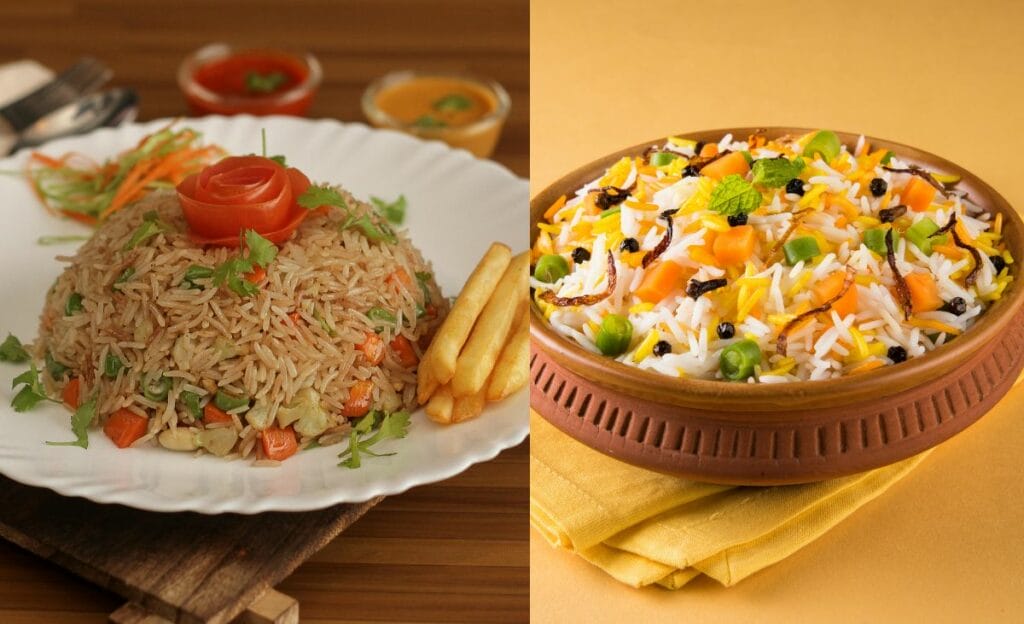
Shared Vegetarian Base
While Veg Biryani and Veg Fried Rice hail from different culinary traditions, they both share a common foundation – they are vegetarian delights. Both dishes celebrate the vibrant flavors of vegetables, making them versatile options for those seeking a meatless culinary experience.
Rice as the Canvas
The most apparent similarity lies in the use of rice as the central element. Whether it’s the aromatic basmati in Veg Biryani or the versatile jasmine rice in Veg Fried Rice, rice serves as the canvas upon which the culinary artistry unfolds. The grains become the vessel to carry the delightful medley of flavors in each spoonful.
Adaptable to Personal Preferences
Another shared characteristic is the adaptability of both dishes. Both Veg Biryani and Veg Fried Rice provide ample room for personalization. You can customize the ingredients, adjusting the spice levels, adding favorite vegetables, or incorporating protein sources like tofu or paneer to suit your taste preferences.
Aromatic Symphony
Despite their geographical differences, both dishes boast an aromatic symphony that tantalizes the senses. Whether it’s the fragrant blend of spices in Veg Biryani or the enticing notes of soy sauce and sesame oil in Veg Fried Rice, these dishes prove that aromatic excellence is a language spoken universally in the world of food.
Common Pairing with Condiments
Veg Biryani and Veg Fried Rice both play well with condiments. Whether it’s the refreshing contrast of raita with Veg Biryani or the popular pairing of chili sauce or soy sauce with Veg Fried Rice, the dishes invite you to explore various accompaniments, enhancing the overall dining experience.
Summary
In essence, while Veg Biryani and Veg Fried Rice may have distinct characteristics that set them apart, they share common ground in their vegetarian base, reliance on rice, adaptability, aromatic appeal, and compatibility with a variety of condiments. These similarities showcase the beauty of diverse culinary traditions converging on a shared love for delicious, plant-based meals.
How to make Veg Fried Rice?
How to make Veg Biryani?
Wrapping It Up: A Tale of Two Vegetarian Delights
In the delightful journey through the aromatic world of Veg Biryani and the quick stir-fry magic of Veg Fried Rice, we’ve explored the nuances that make each dish a unique culinary experience. From the regal origins of Veg Biryani to the casual charm of Veg Fried Rice, the differences in color, flavor, ingredients, and nutritional profiles have painted a vivid picture.
Amidst these distinctions, we discovered common threads – a shared vegetarian base, the use of rice as a canvas for culinary artistry, and an openness to personalization. Both dishes beckon with an aromatic symphony that transcends cultural boundaries, inviting us to savor the diversity of global flavors.
So, whether you find yourself drawn to the layered elegance of Veg Biryani or the wok-kissed simplicity of Veg Fried Rice, there’s a world of taste waiting to be explored. The kitchen is your canvas, and these dishes, your palette.
If you’re intrigued by the fascinating differences and surprising similarities between Veg Biryani and Veg Fried Rice, delve into the full article for a deeper understanding of each dish’s origin, flavor profile, cooking techniques, and more. Your culinary adventure awaits!
